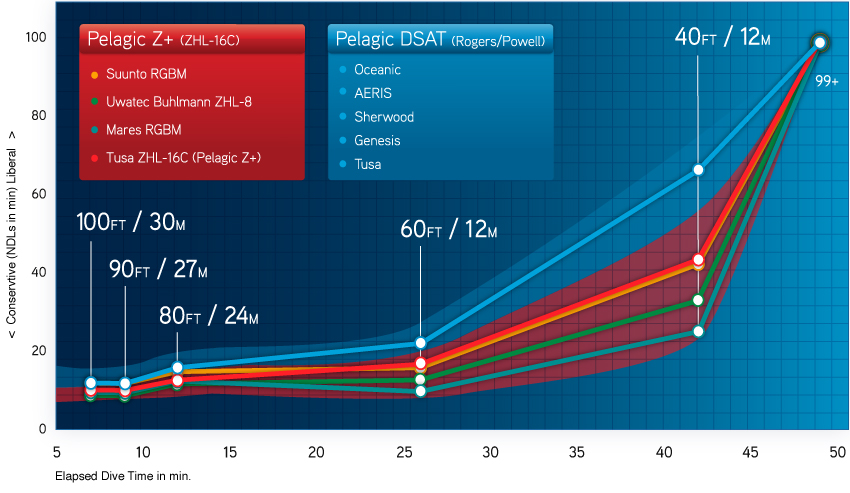
Choose Pelagic DSAT for:
Liberal Recreational Diving
The Pelagic DSAT Algorithm safely maximizes dive time for repetitive, multi-level recreational diving. This algorithm relies on the human Doppler studies used to develop PADI’s Recreational Dive Planner (RDP), and has been the basis of our Dive Computers and other manufacturer's computer algorithms for many years.
To add additional conservatism, you can also adjust the:
- Tissue-Loading Bar Graph Alarm
- Conservative Factor Setting
Choose Pelagic Z+ for:
Conservative Recreational Diving
When applied to standard recreational diving, the Pelagic Z+ Algorithm basis increases the conservative factor of the OC1 by 15-20%.
Liberal Repetitive Deep and Decompression Diving
The Pelagic Z+ uses the Buhlmann ZHL-16C database, which was conducted to meet the more rigorous demands of repetitive, cold-water decompression diving at altitude. The Pelagic Z+ mode maximizes dive times at depth without penalties.
Dive in sync with any buddy, anywhere.
Because the Dual Algorithm allows you to adjust the algorithm basis and its conservatism, you can adjust to closely match just about any other dive computer on the market, allowing you and any buddy to always dive in sync. Diving the same profile increases safety for both divers, and eliminates the need for one person to conduct a much longer or deeper stop when buddying with someone wearing a more liberal dive computer. On repetitive dives, there is no more waiting for the more conservative dive computer to clear. Both buddies will be ready to enter the water at the same time and can continue to dive the same profiles. You can’t control which dive computer your buddy wears, but you can control your ability to dive the same profile.
A note about deep stops:
Both algorithms allow (user ON/OFF option) credit for deep stops for No-Decompression dives in keeping with the data of Morroni et al (2004) and Bennett et al (2007). No penalty is given if the diver skips the deep stop, but it is strongly recommended that a shallow safety stop be made with or without the deep stop in keeping with the experiments of Pilmanis (1975).
It is important to note that neither algorithm provides deep stops for decompression dives since there is ample experimental data [Blatteau et al (2005), Gerth et al (2007), and Gutvik et al (2007)] that indicate that this practice often produces an increase in the risk of DCS.
For more infomation and detailed "Liberal vs Conservative" algorithm comparison charts - see Scuba Diving Magazine's ScubaLab "Digging Deep on 2009's New Dive Computers".
DSAT published & protected by Diving Science & Technology